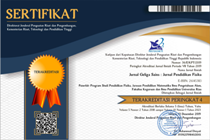Development of Guided Inquiry Learning E-Module Assisted by Virtual Lab on Material of Straight Motion Dynamics
Abstract
Learning is still centered on the teacher with the habit of the lecture method and students only accept what the teacher says so that students do not absorb the full learning. To overcome this, student-centered learning is needed which can be overcome by using learning media, one of which is e-modules. The purpose of this research was to produce an e-module of guided inquiry learning assisted by a virtual lab on valid and practical straight motion dynamics material. This type of research uses research and development (R&D) with the ADDIE development model which is limited to practicality at the development step. The developed e-module is divided into 3 meetings. Data were collected through a validation assessment sheet consisting of material, media, and pedagogic aspects which were validated by 3 experts. In addition, e-module practicality data consisting of ease of use, efficiency, language, and benefits use a practicality assessment sheet. The data obtained were analyzed descriptively. The validation results show that the e-module obtained an average of 3.63 with a valid category, while the results of the practicality test by the teacher's response got an average of 3.73 in the very high category and the average student response results in 3.66 in the very high category. It can be concluded that the guided inquiry learning e-module assisted by a virtual lab on linear motion dynamics material is valid and practical, so it is expected to help high school students in learning physics.
Full Text:
PDF (Bahasa Indonesia)References
Agustia, F. S., & Fauzi, A. (2020). Efektivitas E-Modul Fisika SMA Terintegrasi Materi Kebakaran Berbasis Model Problem Based Learning. Jurnal Penelitian Pembelajaran Fisika, 6(1).
Anitasari, B., Winarti, A., & Rusmansyah, R. (2019). Media simulasi PhET (Physics Education Technology) untuk mereduksi miskonsepsi siswa pada konsep asam basa. QUANTUM: Jurnal Inovasi Pendidikan Sains, 10(1), 8-15.
Astutik, S., Supeno, Prastowo, S. H. B., Prihandono, T., & Bektiarso, S. (2021). Study of Kinematics and Dynamics of Motion at Semanggi Bridge Jember, Indonesia as a Contextual in Physics Learning. Journal of Physics: Conference Series, 1832(1): 012033.
Desstya, A. (2014). Kedudukan dan Aplikasi Pendidikan Sains di Sekolah Dasar. Jurnal Profesi Pendidikan Dasar, 1(2): 193-200.
Fatimah, Ziadatul, Dedi Riyan Rizaldi, A. Wahab Jufri, & Jamaluddin. (2020). Model Inkuiri Terbimbing Berbantuan Laboratorium Virtual untuk Meningkatkan Keterampilan Proses Sains. Jurnal Pendidikan, Sains, Geologi, dan Geofisika (GeoScienceEd Journal), 1(2).
Fatwa, Wawan, M., Harjono, A., & Jamaluddin. (2018). Pengaruh Model Pembelajaran Inkuiri Terbimbing terhadap Keterampilan Proses dan Penguasaan Konsep Sains Ditinjau Dari Pengetahuan Awal Peserta Didik. Jurnal Pendidikan Fisika dan Teknologi 4(1), 121.
Hastuti, W. B. (2021). Meretas Motivasi Belajar Peserta Didik di Era Pandemi Melalui Video Virtual Laboratory. Wawasan. Jurnal Kediklatan Balai Diklat Keagamaan Jakarta, 2(1), 32-39.
Hikmah, N., Saridewi, N., & Agung, S. (2017). Penerapan Laboratorium Virtual untuk Meningkatkan Pemahaman Konsep Siswa. EduChemia (Jurnal Kimia dan Pendidikan), 2(2), 186.
Istyowati, A., Kusairi, S., & Handayanto, S. K. (2017). Analisis Pembelajaran dan Kesulitan Siswa SMA Kelas XI terhadap Penguasaan Konsep Fisika. Prosiding Seminar Nasional III Tahun 2017 (April), 2, 37–43.
Novitayani, L., Sukarmin, S., & Suparmi, S. (2016). Pengembangan Modul Fisika Berbasis Somatic, Auditory, Visual, Intellectual (SAVI) untuk Meningkatkan Kreativitas Belajar Siswa Kelas X SMA/MA dengan Topik Kalor dan Perpindahannya. Inkuiri, 5(2), 20-29.
Tegeh, I. M., Jampel, I. N., & Pudjawan, K. (2015). Pengembangan Buku Ajar Model Penelitian Analyze Implement Evaluate Design Develop. In Seminar Nasional Riset Inovatif, (Vol. 3).
Puspaningtyas, K. (2017). Pengaruh Penerapan Model Inkuiri Terbimbing terhadap Kemampuan Analisis dan Keterampilan Proses Sains. Indonesian Journal of Science and Education, 1(1), 8-16.
Rizaldi, D. R., Jufri, A. W., & Jamaluddin, J. (2020). PhET: Simulasi interaktif dalam proses pembelajaran fisika. Jurnal Ilmiah Profesi Pendidikan, 5(1), 10-14.
Sugiyono. 2014. Metode Penelitian Pendidikan (Pendekatan Kuantitatif, Kualitatif, dan R&D). Bandung: CV. Alfabeta.
Sukardi, M. (2013). Pendidikan-Metodologi Penelitian, Metodologi Penelitian Pendidikan: Kompetensi dan Praktiknya. Jakarta: Bumi Aksara.
Wahyuni, S., Lesmono, A. D., & Fitriya, S. (2021). Pengembangan Petunjuk Praktikum Fisika Berbasis Laboratorium Virtual (Virtual Laboratory) pada Pembelajaran Fisika di SMP/MTs. Jurnal Pembelajaran Fisika, 1(3), 272-277.
Zaturrahmi, Z., Festiyed, F., & Ellizar, E. (2020). The Utilization of Virtual Laboratory in Learning: A Meta-Analysis. Indonesian Journal of Science and Mathematics Education, 3(2), 228-236.
DOI: http://dx.doi.org/10.31258/jgs.10.1.16-26
Refbacks
- There are currently no refbacks.
Copyright (c) 2022 Elsa Farida, Z Zulirfan, Syahril Syahril

This work is licensed under a Creative Commons Attribution 4.0 International License.
Jurnal ini terdaftar dan terindeks pada:
- Crossref
- Google Scholar
- Crossref
- Garuda
- Sinta
- Researchgate
- Dimensions
- Base
- Scilit
- OneSearch
- Road
- CiteFactor
- ResearchBib
- WorldCat



















